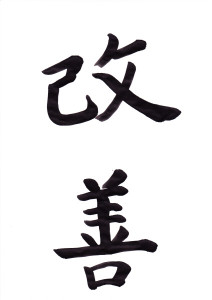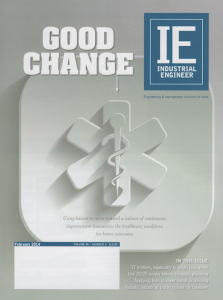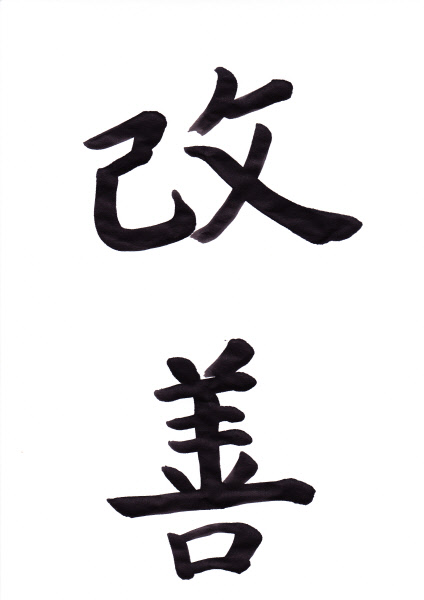What is Kaizen?
Thanks for your interest in Kaizen and continuous improvement. An increasing number of healthcare organizations are embracing this approach as a way of improving quality and safety (for patients and staff), improving the patient experience, and reducing cost.
What is Kaizen?
Excerpted from Chapter 1 of Healthcare Kaizen:
Kaizen = Change for the Better
 The word Kaizen is translated from Japanese in a number of ways, most simply as “change for the better.”
The word Kaizen is translated from Japanese in a number of ways, most simply as “change for the better.”
Breaking down the word and its characters (shown at left):
- “Kai” means “change.”
- “zen” means “good.”
A “Kaizen” is a small improvement that is made by those who do the work. It is a small, low-cost, low-risk improvement that can be easily implemented. Kaizen is an ongoing methodology and philosophy for challenging and empowering everyone in the organization to use their creative ideas to improve their daily work.
The word Kaizen, the way it is typically used, is synonymous with the phrase “continuous improvement.” An effective Kaizen approach is about making improvements that are connected to measurable results and a deeper purpose. Children’s Medical Center (Dallas, Texas), has a process improvement campaign that asks the simple question, “Is there a better way?” Clay York, manager of the core laboratory, and other leaders help tie the department’s local improvement efforts to the organization’s mission and purpose by asking team members if proposed changes will help provide “better care for kids.”
Beyond the measurable results, Kaizen organizations value the personal and organizational learning that results from the improvement process, as well as the personal pride and satisfaction of all who are involved.
Kaizen: A Powerful Word
Kaizen. It is a strange-looking word. It might seem a little difficult to pronounce. Said out loud, it sounds a lot like “try–zen,” and we can equate it with the idea that we can try to improve and make things more zen-like in the workplace. Yes, Kaizen leads to a calmer, better-organized, more productive workplace that provides better patient care. Kaizen seems like a simple concept, really. But is this Japanese word intimidating to people in healthcare workplaces outside of Japan? Does the broader idea of improvement scare or intimidate people at all levels?
Hang in there, as this little word might be one of the most powerful words and concepts for improving healthcare processes and quality. Hospitals around the world are using this concept, often as part of a broader “Lean management” initiative. The period of “Lean healthcare” adoption that started around 2000 has proven that hospitals and healthcare organizations can improve when we have a highly engaged workforce focused on providing value to patients and minimizing waste in the delivery of care.
Many organizations embrace the idea of Kaizen and practice its specific principles, but they call it Continuous Improvement, Process Excellence, or Plan-Do-Study-Act (PDSA) instead of Kaizen. That is perfectly fine; what we call it does not matter as much as the patient benefits, staff engagement, and organizational improvements that we achieve with these practices.
Everybody knows that healthcare organizations and professionals around the world are under a lot of pressure to improve. The need for improvement includes the dimensions of quality and patient safety, cost, waiting times, and the morale of healthcare providers and employees. Kaizen is proving to be part of the solution to these problems.
Read more in Healthcare Kaizen and The Executive Guide to Healthcare Kaizen.
Dr. Gregory Jacobson, an emergency medicine physician, initiated a formal kaizen program at Vanderbilt University Medical Center in 2005 after reading Imai’s book. After the hospital’s success in engaging residents and physicians in kaizen, he published "Kaizen: A Method of Process Improvement in the Emergency Department" in the journal Academic Emergency Medicine. Jacobson and his co-authors summarized the following key kaizen principles:
- Continually improve.
- No idea is too small.
- Identify, report and solve individual problems.
- Focus change on common sense, low-cost and low-risk improvements, not major innovations.
- Collect, verify and analyze data to enact change.
- Problems in the process are a major source of quality defects.
- Decreasing variability in the process is vital to improving quality.
- Identify and decrease non-value-added steps.
- Every interaction is between a customer and a supplier.
- Empower the worker to enact change.
- All ideas are addressed and responded to in some way.
- Decrease waste.
- Address the workplace with good housekeeping discipline.
One other key point about kaizen is that leaders can’t just ask employees to look for cost savings. Experience has shown that healthcare professionals don’t get very excited about saving money as a primary goal. They do, however, get very excited about reducing the risk of harm to patients, improving the patient and family experience, and reducing frustrations and irritations that continually appear in their workdays.
The good news is using kaizen to focus on the types of improvements that engage people will yield cost savings (and sometimes increased revenue) as an end result.
Many kaizen ideas naturally bubble up based on the problems front-line staff members see on a daily basis. But leaders also can ask employees for ideas that tie to a hospital’s balanced scorecard or "true north" goals and objectives.
Free Kaizen Tips
 You can also read an overview
You can also read an overview
article written by Mark Graban
(via the Institute of Industrial Engineers).

